The capital of Portugal is a city that offers a fascinating blend of history, culture and modernity. During your stay, take the chance to visit some of Lisbon's beautiful parks and gardens, which provide a welcome oasis of greenery in the heart of the city. Also, make sure to stroll along the cobblestone streets of the city's historic neighborhoods, where you'll find traditional shops, cafes, and restaurants serving up some of the best seafood in the world.
From the historic neighborhoods to the stunning gardens and the fairytale village of Sintra, this itinerary offers something for everyone. Furthermore, we will also explore the futuristic Oriente district, the bustling Baixa-Chiado shopping area, and the tranquil beaches of Cascais.
With so much to see and do, it can be hard to know where to start. That's why we've put together a list of how to spend 5 days in Lisbon. So pack your bags and get ready to follow us on this memorable adventure!
Wander around Alfama’s narrow streets

What better place to start your journey than in the charming and historic neighborhood of Alfama? With its winding narrow streets, colorful buildings, and rich cultural heritage, Alfama is a feast for the senses and a must-see location for anyone visiting Lisbon.
One of the best ways to experience the magic of Alfama is to simply wander around its labyrinthine streets. As you stroll through the neighborhood, you will encounter an array of surprises around every corner, from hidden courtyards and cozy cafes to stunning viewpoints and historic landmarks. Here you will have the chance to explore its many winding alleys and narrow passageways. These intimate spaces are filled with colorful buildings, vibrant street art, and charming local shops and restaurants. Whether you are in search of a delicious meal, unique souvenirs, or simply a quiet place to reflect, you are sure to find something to suit your tastes in Alfama's picturesque streets.
Keep an eye out for a unique architectural gem known as the Casa dos Bicos. This striking building, with its distinctive façade of diamond-shaped stones, is one of the most interesting and historically significant structures in Lisbon. Casa dos Bicos, which translates to "House of the Spikes," was originally built in the 16th century for the wealthy Portuguese nobleman Afonso de Albuquerque. But over the centuries, it has served a variety of purposes, including as a prison, a tobacco factory, and is now the José Saramago Foundation.
Admire the viewpoints in Graça
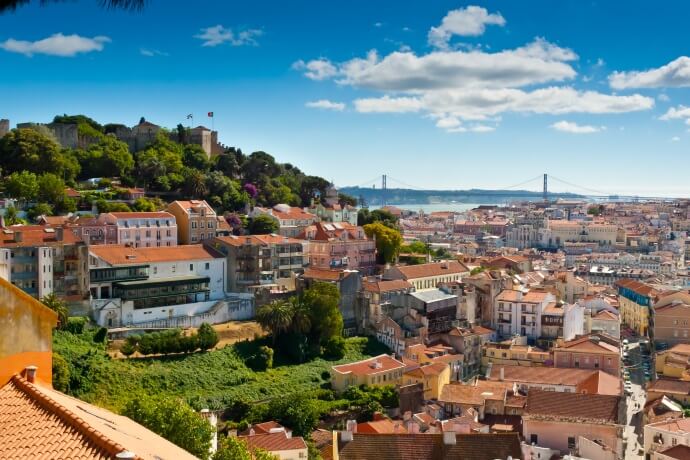
The downtown area of Lisbon is known for its outstanding viewpoints and, talking about these, have your heard about Miradouro da Graça? This scenic lookout point, also known as the Miradouro Sophia de Mello Breyner Andresen, offers stunning panoramic views of the city and its iconic landmarks, including the Castle of São Jorge and the Tejo River.
As you gaze out over the city from Miradouro da Graça, you'll be struck by the beauty and diversity of Lisbon's architecture. The colorful buildings and steep, narrow streets of the Alfama neighborhood give way to the grand boulevards and elegant plazas of downtown Lisbon, while the distant hills are dotted with imposing historic buildings and houses.
The history of this site is just as fascinating as the views themselves. The name "Graça" translates to "grace" in English and it's believed that the lookout point got its name from a 17th century chapel that once stood on the site, dedicated to Our Lady of Grace. Over the centuries, this viewpoint has played an important role in Lisbon's cultural and political history. During the 1755 earthquake that devastated the city, the lookout point served as a refuge for many residents who had lost their homes. In the years that followed, it became a gathering place for political activists and artists, who would come to discuss the issues of the day. Today, it remains a vibrant and bustling destination, attracting visitors from all over the globe who come to admire the views and take in the atmosphere.
Walk around Belém – the museum quarter
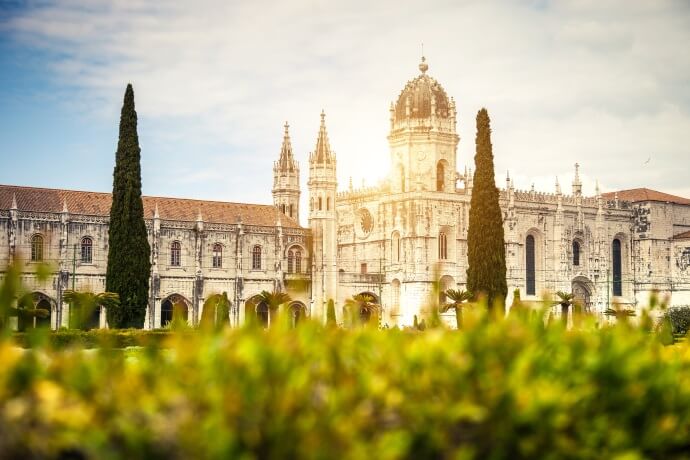
This picturesque quarter is home to some of the city's most renowned museums and cultural institutions, as well as some of its most stunning architecture and scenic views.
To start your walk around the museum quarter, head to the heart of Belém and visit the iconic Jerónimos Monastery. This 16th century masterpiece of Portuguese Manueline architecture is a UNESCO World Heritage Site and one of Lisbon's most visited landmarks. Take your time exploring the intricate carvings and ornate details of the monastery's façade and be sure to step inside to admire the soaring vaulted ceilings and intricate stonework of the interior. Just a short walk away from the monastery, you'll find the Belém Cultural Center, a sprawling complex of museums, galleries, and performance spaces. The center is home to a diverse range of cultural institutions, including the Berardo Collection Museum, which boasts an impressive collection of modern and contemporary art from around the world.
From there, it’s possible to walk to the nearby National Coach Museum, which houses one of the world's most extensive collections of historical carriages and coaches. The museum is located in a former riding school and features more than 50 magnificent vehicles, including ornate gilded coaches used by Portuguese monarchs and members of the nobility.
A visit to the museum quarter in Belém would only be complete if you stop at the iconic Tower of Belém. This 16th-century siege tower was once a vital defense point for the city, guarding the entrance to the Tejo River and protecting Lisbon from invaders. Today, the monument is a UNESCO World Heritage Site and one of Lisbon's most popular landmarks, with stunning views of the river and the surrounding neighborhood.
Go around the world in Mouraria
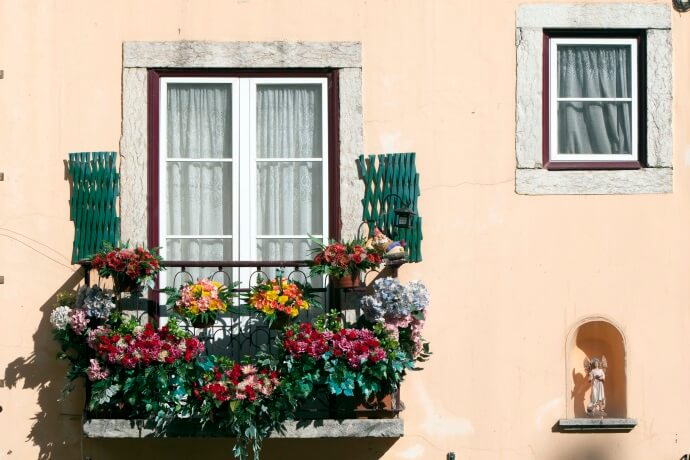
Now it’s time to talk about one of Lisbon’s beloved neighborhoods, Mouraria. Located just a stone's throw away from the city center, this charming area is steeped in history, culture, and tradition. For starters, once in this neighborhood, you can take a walk around and head to the Largo da Severa, a small square that's said to be the birthplace of Fado. From here, continue your walk through the neighborhoods winding streets, taking in the colorful façades of the traditional houses and the charming cobbled alleys.
As you continue to explore, you'll discover a wealth of hidden gems, from quaint cafes and local restaurants to street art and murals. Be sure to stop by some of the neighborhood's cultural and historic landmarks, such as the Casa da Achada, a community center and cultural space that celebrates the history and traditions of Mouraria. Another interesting spot to visit in this neighborhood is the Martim Moniz square, a bustling hub of activity that's home to a vibrant street market, local and international restaurants.
Overall, a walk around the Mouraria neighborhood is a fantastic way to experience the vibrant culture and rich history of Lisbon. From the charming streets and colorful façades to the bustling markets and cultural landmarks, just take the chance to discover and explore this fascinating corner of the city.
Visit the fairy-tale village of Sintra
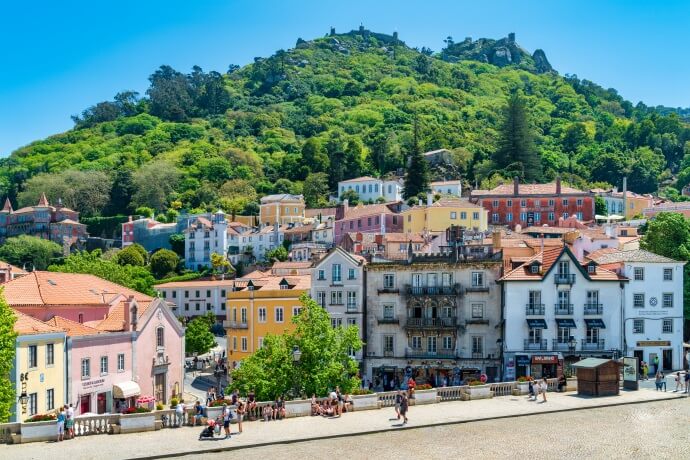
Nestled amidst the lush hills and verdant forests of the Serra de Sintra, this charming town is home to a wealth of historic landmarks, stunning natural beauty and a whimsical, fairy-tale atmosphere that's sure to captivate your imagination. To begin your visit to Sintra, start with the town's most famous attraction, the colorful and ornate Pena Palace. This stunning 19th century palace, built on the site of an ancient monastery, is a masterpiece of Romantic architecture! With its fanciful towers, turrets and bright pastel colors, make sure to enter the palace's opulent interiors and wander the lush gardens and terraces that surround it, offering breathtaking views of the surrounding landscape.
From there, head to the historic center of Sintra, where you will find a maze of narrow streets lined with historic homes, artisan shops and local cafes. Take a stroll through the town's charming alleys and make sure to stop by some of the local landmarks, such as the imposing National Palace of Sintra, and the whimsical Quinta da Regaleira. As you explore Sintra, make sure to sample some of the town's delicious local cuisine, such as the famous "travesseiros" pastry, made with sweet almond paste, and the local "queijadas" (cheesecakes).
A visit to the fairy-tale village of Sintra is a magical experience that will transport you to a world of beauty and historic grandeur!
Do the Fado Trail in Alfama & Mouraria

Have you been looking for an immersive cultural experience in Lisbon? Then discover more about Fado in Alfama and Mouraria, where the soulful melodies of Fado have been heard for centuries. Fado is a traditional Portuguese music genre that is characterized by mournful and melancholic songs that reflect on the trials and tribulations of life.
The genre is deeply rooted in Portuguese culture so it is definitely worth it to stop at one of the many Fado houses that dot the area. These intimate venues provide the perfect setting to enjoy the emotional and powerful performances of Fado singers, accompanied by the sweet sounds of the Portuguese guitar, each one showcasing the raw emotion and power of this unique musical genre. From the mournful ballads of the old Fado masters to the contemporary interpretations of modern artists, take the chance to experience the delight of this powerful musical tradition.
Discover futuristic Lisbon
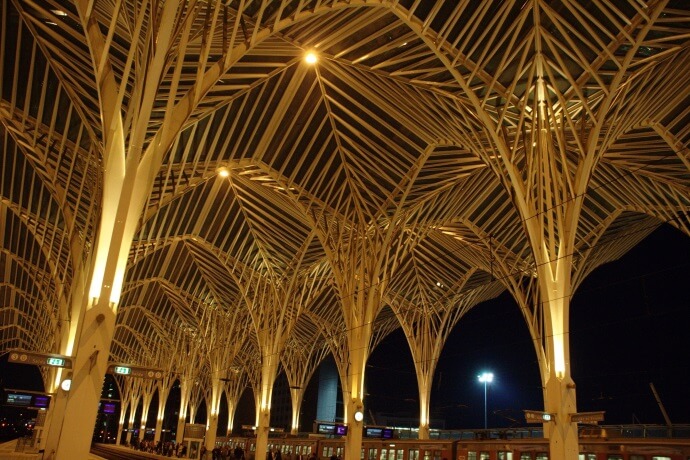
Located in the eastern part of the city, the futuristic district of Oriente is a stunning example of modern architecture and design, with sleek lines, bold colors and innovative structures that will leave you in awe. The centerpiece of Oriente is the Gare do Oriente, a train station designed by the renowned Spanish architect Santiago Calatrava, a masterpiece of modern engineering, with a soaring roof that resembles the skeleton of a giant bird.
As you explore Oriente, you will encounter a wide range of other stunning structures, including the Vasco da Gama Bridge, one of the longest bridges in Europe and the Vasco da Gama Tower, a towering structure that offers outstanding views of the surrounding area. But Oriente isn't just about architecture and design – it's also a hub of cultural activity! The district is home to a range of cultural institutions and museums, including the Lisbon Oceanarium, one of the largest aquariums in Europe, and the Lisbon Casino, a sprawling entertainment complex that offers everything from gaming to live performances.
Go to the traditional shops in Chiado
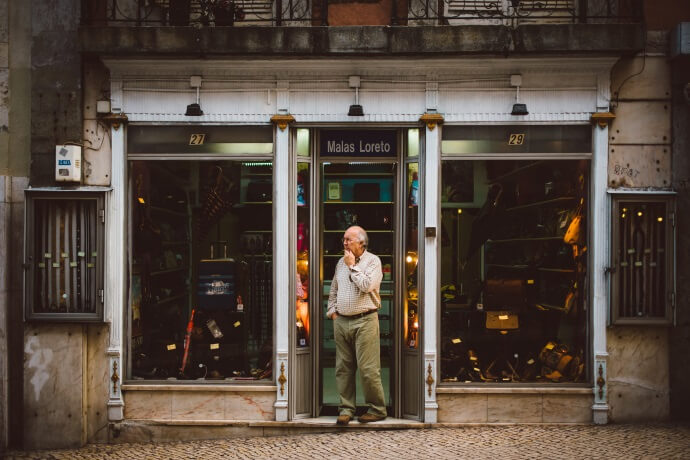
When it comes to shopping in Lisbon, what better place than Chiado? This historic neighborhood, located in the heart of the city, is a haven for shoppers, with a great range of traditional shops and boutiques that offer everything from handmade crafts to designer fashion.
One of the best things about shopping in Chiado is the opportunity to discover traditional Portuguese products and crafts. Here, you will find shops selling everything from locally made pottery and ceramics to intricate lacework and embroidered textiles. A Vida Portuguesa is an example of this, offering a carefully curated selection of traditional Portuguese products, from soaps and candles to gourmet food items and home decor. If you're in the market for fashion, Chiado has plenty to offer as well. The neighborhood is home to a number of high-end boutiques, including international brands, as well as local designers who offer unique and one-of-a-kind pieces. For those interested in vintage clothing, there are also a number of vintage shops in the area.
As you continue strolling through the charming streets of Chiado, you will also encounter a number of specialty shops that cater to specific interests. For example, there's Livraria Bertrand, the oldest bookstore in the world, which has been a fixture in the neighborhood since 1732. There's also Luvaria Ulisses, a tiny glove shop that has been handcrafting gloves for over 90 years.
Ride the tram
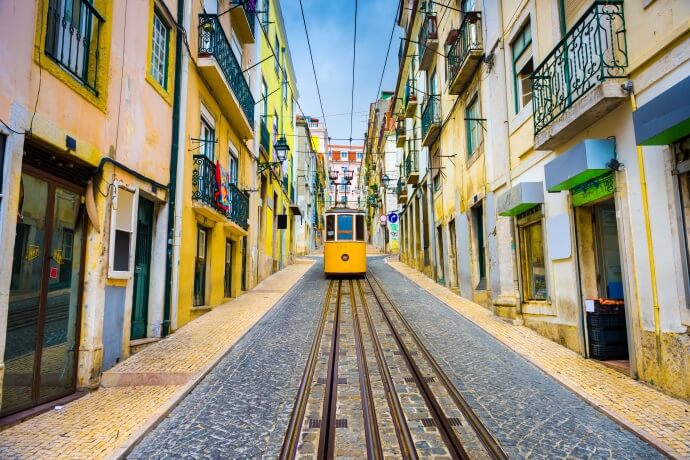
One of the best ways to explore the charming and historic neighborhoods of Lisbon is by riding the city's iconic trams. The tram number 28 became so popular that nowadays it’s quite difficult to experience it. So, we are here to show you two of the best alternatives to the 28 tram, which are, the famous Bica Lift and the Lavra Elevator.
The Bica Lift, also known as the Ascensor da Bica, is located in the Bica neighborhood, one of the oldest and most picturesque areas in Lisbon. This historic lift-tram has been in operation since 1892 and is a beloved icon of the city. As you ride the lift up the steep hill, you will be treated to stunning views of the colorful buildings and narrow streets below. Once you reach the top, you will find yourself in the heart of the Bica neighborhood, where you can explore the charming cafes, restaurants and shops that line the streets.The Lavra Elevator is another historic lift-tram that also offers amazing views of the city. The elevator is located in the historic center of Lisbon and has been in operation since 1884, making it the oldest funicular in Lisbon. As you ride the tram up the hill, you will marvel at the city’s panoramic views and the surrounding landscape. Once you reach the top, you can explore the beautiful Jardim do Torel park, which offers a peaceful retreat from the bustling city streets.
Visit Lx Factory and admire the art
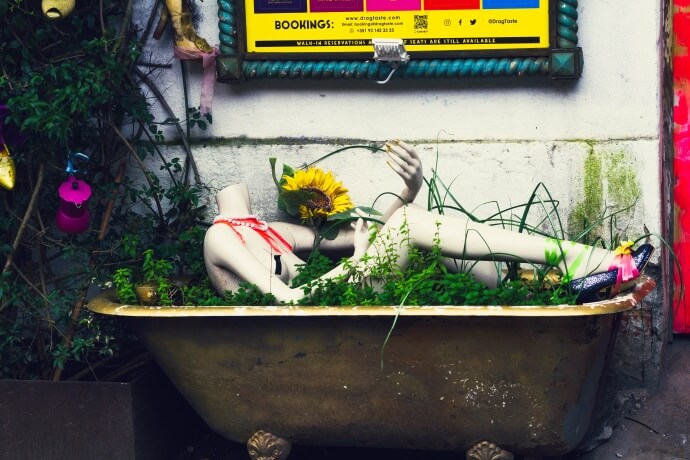
This former industrial complex has been transformed into a vibrant hub of shops, restaurants, galleries and more. Located in the Alcântara neighborhood, LX Factory is easily accessible by public transportation or by car. Once you arrive, you will immediately notice the industrial charm of the area, with old warehouses and factories now repurposed into trendy boutiques and art spaces. One particularly unique shop is Ler Devagar, a bookstore housed in an old printing press that still has its original machinery on display.
Art lovers will also find plenty to appreciate at LX Factory. The complex is home to several galleries and art spaces, where you can admire street art and contemporary art installations from local and international artists.
Head to Cascais and relax by the sea
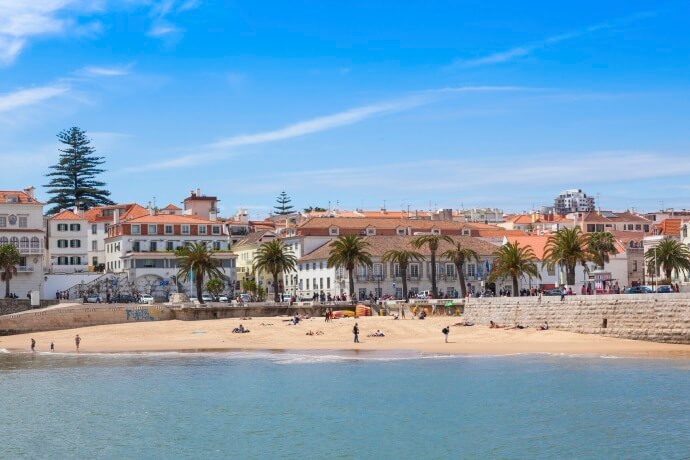
The charming seaside town of Cascais is just a short train ride from Lisbon and offers plenty of opportunities to relax and enjoy the beauty of the Atlantic Ocean. Once you arrive, the first thing you will notice is the beautiful coastline. The town is home to some stunning beaches, each with its own unique vibe.
Cascais is also home to a charming town center. Take a stroll through its cobblestone streets and admire the colorful buildings and local shops. You will also find plenty of restaurants and cafes serving up delicious seafood and traditional Portuguese dishes. For a truly relaxing day, head to the Marina de Cascais. This picturesque harbor is a great location to watch the boats come and go, or simply sit back with a glass of wine and enjoy the view. You will also find several cafes and restaurants here, making it a great place for lunch or dinner.
Explore the gardens and relax in the shade
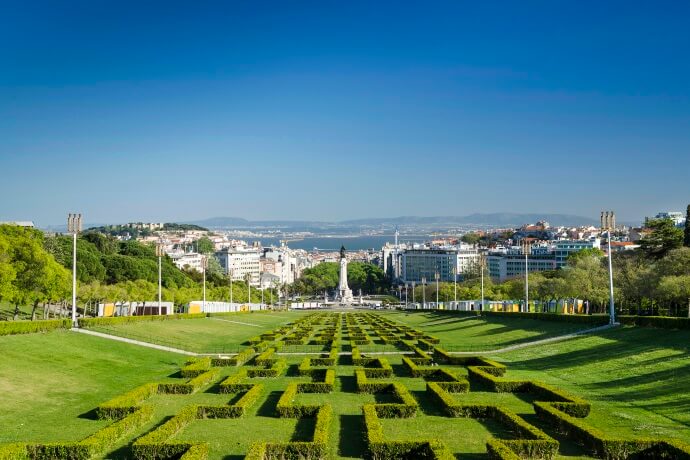
Lisbon is famous for its stunning architecture and vibrant culture, but it's also home to some of the most beautiful gardens in Europe. There are plenty of options when it comes to exploring the marvelous gardens around the city. Starting at Parque Eduardo XVII, offering great views of downtown towards the river and with plenty of opportunities to relax and unwind. One of the highlights is the stunning Estufa Fria, a massive greenhouse that's home to a variety of exotic plants and flowers. Take a stroll through the colorful displays and marvel at the stunning beauty of nature.
Another must-visit garden in Lisbon is the Calouste Gulbenkian museum garden. This stunning space is home to a variety of exotic plants and trees from around the world, as well as several beautiful sculptures and fountains. Take a seat on one of the many benches and feel the peaceful atmosphere, or wander through the gardens and admire the stunning works of art.
Another great option can be found at the neighborhood of Campo de Ourique, the famous Jardim da Estrela, a 4-hectare garden designed in a romantic style, with winding paths, secluded benches and a large pond. This garden was originally created in the late 19th century and today, it is a popular spot for locals and tourists alike, who come to enjoy its serene beauty. One of the most striking features of Jardim da Estrela is its lush greenery. The garden is home to a wide variety of trees and plants, including towering palm trees, fragrant jasmine bushes and colorful azaleas. There are also many fountains, sculptures and statues throughout the park, which add to its charm.



